

"Any other comments?" Open questions on questionnaires – a bane or a bonus to research? Open-Ended vs. Closed-Ended Questions in User Research. Introduction When conducting usability studies or field studies, it’s a great idea to ask lots of open-ended questions.
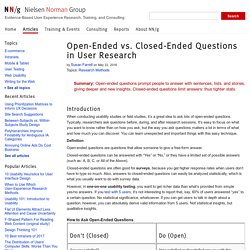
Typically, researchers ask questions before, during, and after research sessions. It’s easy to focus on what you want to know rather than on how you ask, but the way you ask questions matters a lot in terms of what and how much you can discover. You can learn unexpected and important things with this easy technique.
Definition Open-ended questions are questions that allow someone to give a free-form answer. Closed-ended questions can be answered with “Yes” or “No,” or they have a limited set of possible answers (such as: A, B, C, or All of the Above). Closed-ended questions are often good for surveys, because you get higher response rates when users don’t have to type so much. However, in one-on-one usability testing, you want to get richer data than what’s provided from simple yes/no answers. Open and Closed-ended Questions.
One of the most significant decisions that can affect how people answer questions is whether the question is posed as an open-ended question, where respondents provide a response in their own words, or a closed-ended question, where they are asked to choose from a list of answer choices.
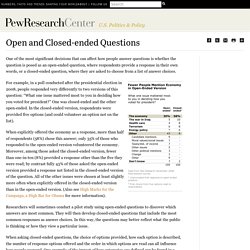
For example, in a poll conducted after the presidential election in 2008, people responded very differently to two versions of this question: “What one issue mattered most to you in deciding how you voted for president?” One was closed-ended and the other open-ended. In the closed-ended version, respondents were provided five options (and could volunteer an option not on the list). When explicitly offered the economy as a response, more than half of respondents (58%) chose this answer; only 35% of those who responded to the open-ended version volunteered the economy. Are Open-Ended Questions Qualitative Research? - Infosurv. Many researchers refer to the responses to open-ended survey questions as qualitative research.
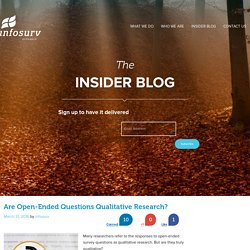
But are they truly qualitative? Qualitative research is primarily exploratory research to gain an understanding of underlying reasons, opinions, and motivations for consumer behavior. It can also provide insights into the research problem or develop hypotheses for testing in subsequent quantitative research. Qualitative data collection methods use unstructured or semi-structured question techniques, including focus groups discussions, individual interviews, and participation/observations. The sample size is typically small, and respondents are selected to fulfill a given quota. Quantitative Research, on the other hand, is used to quantify the problem, to generate numerical data or to provide data we transform into usable statistics. Open-Ended Questions: Your Ticket to Qualitative Data.
What type of data are you looking for in your survey?
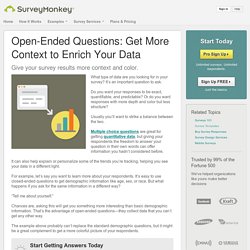
It’s an important question to ask. Do you want your responses to be exact, quantifiable, and predictable? Or do you want responses with more depth and color but less structure? Usually you’ll want to strike a balance between the two. Multiple choice questions are great for getting quantitative data, but giving your respondents the freedom to answer your question in their own words can offer information you hadn’t considered before. It can also help explain or personalize some of the trends you’re tracking, helping you see your data in a different light. For example, let’s say you want to learn more about your respondents. “Tell me about yourself.” Chances are, asking this will get you something more interesting than basic demographic information. The example above probably can’t replace the standard demographic questions, but it might be a great complement to get a more colorful picture of your respondents.
Start Getting Answers Today. RWJF - Qualitative Research Guidelines Project. Characteristics of Unstructured Interviews The interviewer and respondents engage in a formal interview in that they have a scheduled time to sit and speak with each other and both parties recognize this to be an interview.
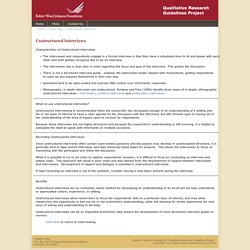
The interviewer has a clear plan in mind regarding the focus and goal of the interview. This guides the discussion. There is not a structured interview guide. Instead, the interviewer builds rapport with respondents, getting respondents to open-up and express themselves in their own way. RWJF - Qualitative Research Guidelines Project. Characteristics of the Structured Interview The interviewer asks each respondent the same series of questions.
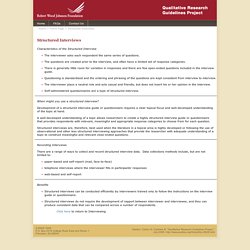
The questions are created prior to the interview, and often have a limited set of response categories. There is generally little room for variation in responses and there are few open-ended questions included in the interview guide. Questioning is standardized and the ordering and phrasing of the questions are kept consistent from interview to interview. The interviewer plays a neutral role and acts casual and friendly, but does not insert his or her opinion in the interview. Open-Ended Survey Questions: Challenges and Opportunities. Tipsheet%20 %20Qualitative%20Interviews. Qualmethods. Qualitative Interview Design.
Qualitative Research Interviews. Interview%20Fri. Brief Guide to Open Ended Survey Questions. Pr section 3. Popping. CarletonMarineBiologyExecutiveSummary2006. Focus Group Questionnaire Fundamentals. Basic questions are tools in qualitative research.
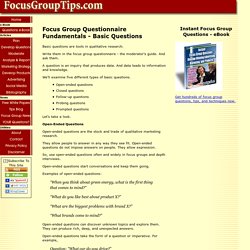
Write them in the focus group questionnaire - the moderator's guide. And ask them. A question is an inquiry that produces data. And data leads to information and knowledge. We'll examine five different types of basic questions.